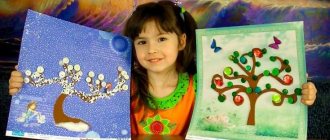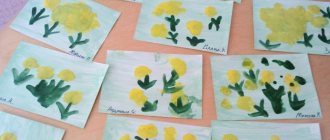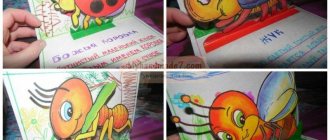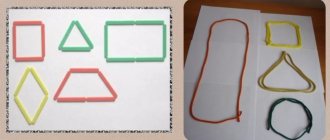Conducting an educational activity on drawing on a chosen topic with children 6–7 years old
The object of the study is the process of drawing expressive images by children of senior preschool age using non-traditional techniques.
Subject of research: pedagogical possibilities of non-traditional techniques and materials in the development of expressive images in the drawings of children of senior preschool age.
Tasks:
- Study psychological and pedagogical literature and literature on the visual activities of children in a preschool institution;
- Make an analysis of the age characteristics of older preschoolers and the quality of children's drawings;
- Conduct research work on the quality of children's drawings using non-traditional techniques;
- Develop a development program for the development of creative abilities in art classes using non-traditional drawing techniques.
Carrying out educational activities with children 6-7 years old
A selection of demonstration materials for the conversation (photos and drawings)
Demonstration material is selected in accordance with the topic. The kindergarten teacher prepares illustrations from which new drawings, layouts, reproductions, subject or didactic pictures will be created. A perspective free plan helps children create expressive images.
Music and poetry appropriate to the topic of the lesson
To instill interest in artistic activity, the teacher must satisfy the needs of preschoolers. It is very important to select music according to the topic. For example, if a masterpiece is created on the theme “Winter”, then you need to choose the tunes “If only there were no winter”, “Three White Horses”, “New Year”, “Snow Maiden”. During the warm-up, you can read poetry, for example, “The bird that sings in the garden.”
Summary of a drawing lesson in the chosen technique in the preparatory group
Drawing in the preparatory group according to the Federal State Educational Standard is a unique way of understanding the world and developing knowledge of aesthetic education, since it is associated with the child’s independent practical and creative activity.
Systematic mastery of all necessary means and methods of activity provides children with the joy of creativity and their all-round development (aesthetic, intellectual, moral-labor, physical). It also allows us to fruitfully solve the problems of preparing children for school.
Examples of finished works
Children put their finished work on the table so that the teacher can evaluate their talent. Most often, children like to draw images on the theme “Defender of the Fatherland Day”, “March 8”, “Autumn”, “Spring has come”, “The coldest month”, “Profession”, “Forest”, “Why day follows night”, “Clothing” ", "Our kindergarten is like a home."
Works of preschoolers
The most popular theme for children is “Headdress”. The children learn to correctly name hats and their parts, telling what types they come in. For example, to come to the beach, you need to wear a Panama hat and a hat. When late autumn comes, women wear scarves and light scarves. And already in February and January you need to wear a warm pompom.
We train memory and attention in children of senior preschool age
Summary of a lesson on visual arts in the preparatory group of a kindergarten
Summary of a lesson on visual arts in the preparatory group of a kindergarten
Topic: Little Brothers - Soldiers. We need to remember their feat! Goal: to form the foundations of patriotism by introducing children to the role of animals that took part in the Great Patriotic War. Objectives: Educational:
1. To develop the ability to expressively convey images of animals in a drawing (body shape, location and shape of body parts, their size, proportions) based on a diagram.
2. Enrich children’s understanding of animals that took part in the Great Patriotic War. Developmental:
1. Develop technical skills and abilities in depicting animals.
2. Develop the ability to compose a plot composition based on a performance on a patriotic theme. 3. Develop the ability to write a story about your drawings and the drawings of your comrades. 4. Promote the development of perception, attention, memory and imagination. Educational:
1. Foster love for the Motherland, for nature;
humane treatment of animals. 2. Develop cooperation and co-creation skills. Materials and equipment: computer, presentation, phonogram of the song “Victory Day”, wax crayons, felt-tip pens, diagrams of step-by-step drawing of animals. Educational areas in integration: - artistic and aesthetic development - social and communicative development - cognitive development - speech development Preliminary work: examination of illustrations about animals in war;
reading poems, stories about animals that helped soldiers; compiling stories about animals based on paintings; modeling of animals. Course of the lesson
1. Introductory part Educator: There is a parade, fireworks are thundering, orchestras are sounding here and there, Not only great-grandfathers and grandfathers are celebrating the glorious Victory Day! The Great Patriotic War left a sad mark on the history of our country and the whole world. The feat of the Soviet people is difficult to overestimate. And few people know that at that terrible time, our smaller brothers proudly and bravely fought side by side with the soldiers. -Who do we call our little brothers? Children: Dogs, cats, horses, pigeons, dolphins... Educator: Today we will remember only some of them. 2. Main part Educator: (slide show)
Animals, like people, performed feats on the fields of war.
As heroes, animals saved thousands of human lives and brought the long-awaited Victory Day closer. Why do you think dogs served humans so faithfully? (children's answers)
.
That's right, dogs, as devoted and faithful friends of humans, performed a variety of tasks. It’s not for nothing that we respect the dog: The dog at the front was an orderly, a signalman, a sapper. Sometimes dogs rushed at tanks during an attack. Yes, during the war it turned out that the “tigers” and “panthers” were afraid of dogs. Educator: (slide show)
They took wounded soldiers from the line of fire and delivered ammunition to the battlefield.
Signal dogs delivered important orders. They pulled communication lines, looked for mines, and blew up enemy tanks. Dogs performed feats without knowing it. They simply did what people taught them and died, just like people. But by dying, they saved thousands of human lives. Educator: (new slide)
Despite the fact that World War II was called the war of engines, cavalry played an important role in it.
Educator: How do you think the horses helped the soldiers? (children's answers)
During the war, horses were used as a transport force, especially in artillery.
A team of six horses pulled the cannon, changing the firing positions of the battery. Food convoys and field kitchens were delivered to positions by horses. The wounded owed their lives to horses: most of the infirmaries were horse-drawn. Educator: (new slide)
Oddly enough, the symbol of peace - the dove - turned out to be very useful in war.
How could the pigeons help? (children's answers)
The army used carrier pigeons.
During the war years, carrier pigeons delivered a huge number of pigeon messages. The Nazis called them “feathered partisans.” Pigeons posed such a threat to the enemy that the Nazis specifically ordered snipers to shoot pigeons and even trained hawks on them. Educator: How can you ensure that your impressions of the knowledge gained remain in your memory as long as possible? So you can clearly share them with your friends? Children: You can draw your impressions. 3. Practical work. — Now you will try to convey your impressions of the story in drawings. Depict the animals that helped people on the WWII fronts. — Where do you start drawing any animal? (from the body)
- What shape is the body of the animal?
(oval)
- What shape can the head be?
(round and oval or elongated)
- What shape are the ears?
(triangular, oval, round)
- What shape are the paws?
(oval)
How many paws do animals have?
(four)
.
In birds? (two) (pay attention to the diagrams of animals)
- Guys, pay attention, animals have different colors and hair lengths.
— How should the animal be placed on the sheet? (large, in the center)
The animal can stand, walk, lie down, run.
The location of body parts relative to each other depends on this. (paws bent, extended, head turned, etc.)
- To start drawing, you need to stretch your fingers.
Finger gymnastics “Our true friends” One, two, three, four, five, (we bend the fingers on our right hand one by one)
Let us count our friends.
(we bend the fingers on the left hand one by one)
The closest, the most faithful -
(we connect the fingers of both hands one by one, Everyone probably knows them, big with big, etc.)
Dogs, horse, pigeon, cats
(we bend the fingers of both hands at the same time)
Let's clap their hands.
(clap our hands)
We were with the person next to us
(clasp our hands)
We served on the war fronts.
(we raise and lower our fingers)
We will see them here and there,
(we tilt the castle to the right and left)
Our fiery salute to them!!!
(raise our hands up and clap our hands)
Children sit at the drawing tables.
— Guys, think about which animal you remember most, which one you will draw. The tables have all the necessary materials. You can start working. (The children begin to work. The music “Victory Day” and others plays softly in the background.)
During the work, the teacher guides the children, encourages their initiative, asks leading questions, and draws the children’s attention to the diagrams of animal images.
— To color the background of the work, what technique can you use? (technique of drawing with a “die”) 4. Summary of the lesson Children display their finished works at the exhibition “Four-legged and winged war heroes.”
- Who will tell you about your drawing? — What title can you give to your work? — What works at the exhibition did you like? Educator: Much has changed since the war, but you and I must remember those who accomplished the feat, for the sake of life and for the sake of peace on earth. We must remember those who died, giving us the opportunity to see clear skies above our heads. Remember a person’s good friends who helped him on the difficult path to victory! Peace is the best word in the world, Adults and children strive for peace, Birds, trees, flowers on the planet. Peace is the most important word in the world! Presentation on the topic: Little Brothers - Soldiers
We recommend watching:
Scenario for a musical literary lounge for May 9 in kindergarten. Preparatory group
Similar articles:
War stories for schoolchildren
9th May. Victory Day scenario for elementary school
Where to celebrate Victory Day, May 9?
Scenario of the concert for Victory Day on May 9
Victory Day. 9th May. Scenario for kindergarten



